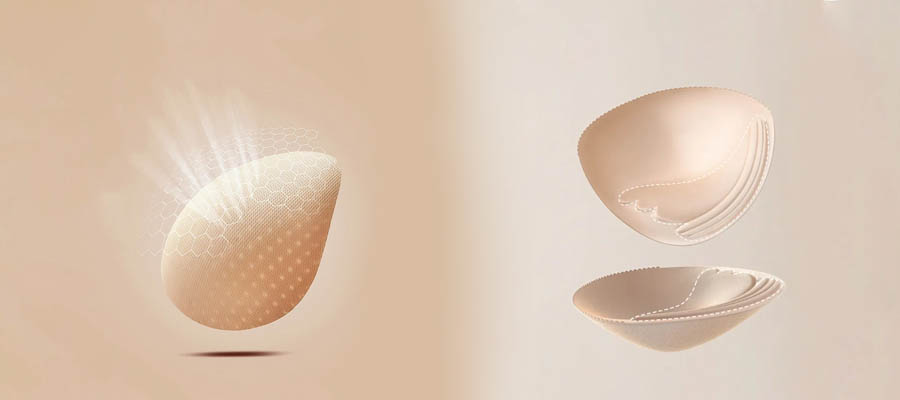Bra cup material options are increasingly diverse on the market. A deeper understanding of different bra cup materials will help you better optimize your product structure and market positioning.
If you’re looking for lightweight comfort, we recommend 3D breathable cotton or honeycomb cotton. Eco-conscious brands can opt for recycled foam and other eco-friendly materials. For support and focus, memory foam is a common and practical fabric.
This article systematically introduces common bra cup material types and their characteristics to help you make informed material choices.
Common cup materials:
Foam
Definition:
Ordinary foam is made from polyurethane foam. It is soft, lightweight, elastic, and supportive, and is widely used in bra cups.
Process:
It uses a hot press mold to heat and press the foam into various cup shapes. The thickness can also be flexibly controlled to meet different styles.
Features:
This material is low-cost, highly malleable, and easy to shape and mass-produce. It also provides excellent shaping properties and is commonly used in push-up cups, padded cups, and molded cups.
The only drawback is that it lacks breathability, making it easy to feel stuffy after prolonged wear. Therefore, it is suitable for autumn and winter underwear.
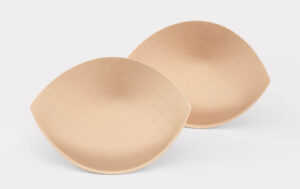
Memory Foam
Definition:
Memory foam, also known as slow-rebound foam, is a high-density polyurethane foam that is particularly sensitive to pressure and body temperature. It “remembers” the contours of the breasts and slowly returns to its original shape after pressure is removed, hence the name memory foam.
Processing:
To enhance the bra cup structure, memory foam is often laminated to a cover fabric (such as lace or knit fabric) before the entire cup is pressed or shaped.
Memory foam requires strict temperature and time control during the production process. Excessively high temperatures will impair its resilience, while excessively low temperatures will prevent it from setting.
Features:
Memory foam can adapt to the wearer’s breasts, providing high comfort and gentle support. It is often used in high-end lingerie and product lines requiring a precise fit.
Drawbacks include a relatively long production cycle and higher costs than ordinary foam, making it less suitable for ultra-low-priced products.
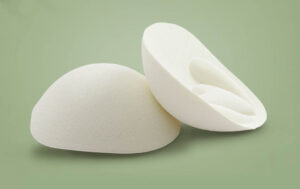
3D Breathable Foam
Definition:
3D breathable cotton, also known as spacer fabric, is a high-performance fabric with a honeycomb or three-dimensional grid structure that allows air to circulate freely, resulting in excellent ventilation and a lightweight feel. It is recognized as a new generation of functional bra cup material.
Process:
This fabric is made through a woven process with a high middle layer and a low surface layer, creating a honeycomb pattern of breathable holes. The woven fabric is cut and formed through heat pressing or cold molding to create a 3D bra cup structure.
Features:
The honeycomb structure provides extremely high breathability. Compared to other foams, it is thinner and lighter, making it particularly suitable for summer bras, sports bras, and lightweight bras, while maintaining appropriate support, comfort, and style.
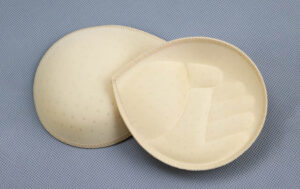
Honeycomb Cotton
Definition:
Honeycomb foam is a specially structured fabric-laminated cotton material. It looks similar to 3D breathable foam, but its material and structure differ. This structure is achieved by perforating and compressing sponge or cotton batting in a specific manner to create a honeycomb-like arrangement. It is lightweight, soft, breathable, and fluffy, and is commonly used as the inner filling for bra cups.
Process:
The sponge is mechanically punched or laser-cut to create a regular hexagonal honeycomb structure. This structure is not suitable for high-temperature hot pressing, which can easily collapse the honeycomb structure, so it is usually used for cutting and sewing bra cups.
Features:
Natural material, soft touch, and non-irritating to the skin.
The honeycomb structure allows for air circulation.
Commonly used for soft cups, nursing cups, and underwireless bra cups.
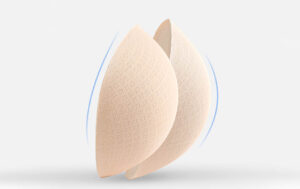
Molded Fabric
Definition:
Molded fabric is a bra cup that does not contain sponge. It uses a heat-setting process to heat and press a flat fabric into a three-dimensional cup shape that conforms to the female breast shape. The cup’s contour is achieved solely through the fabric’s inherent structure and the shaping technique.
Process:
Generally, fabrics with elasticity and heat-setting properties are selected. Commonly used molded fabrics include nylon with spandex, polyester, and microfiber. A mold is heated to 120-180°C, and the fabric is placed into the mold. The high-temperature heat press forms the cup shape.
This process requires high fabric elasticity and stability, and is not suitable for fabrics that are too thin or too thick. Fabrics that are too thin will easily deform, while fabrics that are too thick will not easily create a three-dimensional effect.
Features:
This bra contains no sponge, is very light, comfortable next to the skin, maintains natural curves, and is breathable. It is commonly used to make lightweight, unpadded bras and seamless bras.
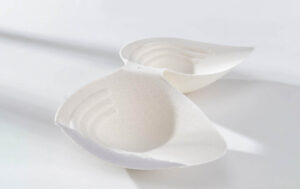
3D Vertical Cotton
Definition:
3D upright foam is a foam material with a vertical fiber structure. Its fibers are arranged vertically, like countless small pillars supporting the breasts. This structure provides excellent support and sturdiness. Although the name contains “cotton,” the core material is made of polyester or modified polyurethane fibers, not actual cotton.
Processing:
The raw polyester fibers are passed through a specialized upright foaming machine to align the fibers vertically. Then, they are shaped using hot air to stabilize the fiber structure and prevent collapse. The foam is then cut or molded according to the cup template.
Features:
The vertical fiber structure provides excellent support. It is widely used in bra cups that require push-up. The material also exhibits excellent resilience, preventing deformation even under prolonged compression.
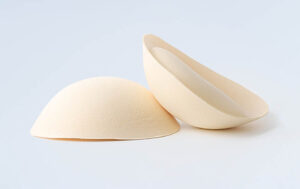
EVA Foam
Definition:
EVA Foam, or ethylene-vinyl acetate copolymer foam, is a high-performance foam material. It offers excellent formability, water resistance, and stability. In bra cup applications, EVA Foam is used to provide structural support in functional bra designs.
Process:
Ethylene-vinyl acetate copolymer (EVA) resin is mixed with a blowing agent and a cross-linking agent. The foam is then foamed at high temperatures, forming a closed-cell foam structure. After cooling, the EVA material is compression molded into the bra cup shape.
Features:
Compared to ordinary sponges, EVA Foam offers greater support and maintains its shape even after long-term wear. The material itself is lightweight and non-absorbent. Some EVA components are recyclable, making it suitable for brands with a sustainable mindset.
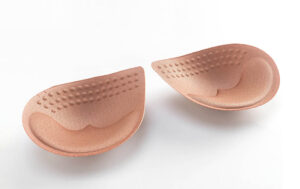
Recycled Foam
Definition:
Recycled fiber foam is made from recyclable materials. It offers the lightness and softness of traditional foam while also being environmentally friendly.
Process:
The production of recycled foam begins with collecting recycled raw materials, cleaning them, melting them, and then repolymerizing them into polyester fibers. This is then foamed to form a foam structure, which is then molded or cut into cup shapes.
Features:
It offers consistent resilience, support, and breathability, meeting brand requirements for green and sustainable materials. It’s suitable for a variety of cup styles, including thin-molded cups, padded cups, and draped cups.
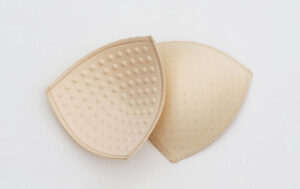
how to keep the material on bra cups from shrinking?
The possibility of shrinkage can be reduced through the selection of raw materials, production process control and end-user care.
Raw Material Selection
During the production process, choosing pre-shrunk fabrics can reduce shrinkage in the finished product. Choose materials with inherent shrinkage resistance, such as polyester and nylon.
Production Process Control
Before lamination, the foam is pre-treated with hot air or heat pressing to enhance the fiber’s dimensional stability.
During the molding process, controlling the temperature and time is also crucial to prevent shrinkage. After molding, the bra must be completely cooled and set before demolding. Removing the bra too early may cause the bra cups to shrink and deform.
Post-molding Care
Hand washing is recommended. Avoid excessive ironing or tumble drying.
Conclusion
This article introduces eight different bra cup materials, each with its own unique advantages. For example, regular foam is easy to process and affordable, memory foam offers excellent conformability, 3D breathable foam is suitable for lightweight summer wear, and recycled foam is more environmentally friendly. Understanding the characteristics of these materials can help you better navigate material selection and product development.
After reading this article, if you are still unsure about material selection, we can give you more professional suggestions based on your needs, help you control the quality, and create a bra product that satisfies you.

